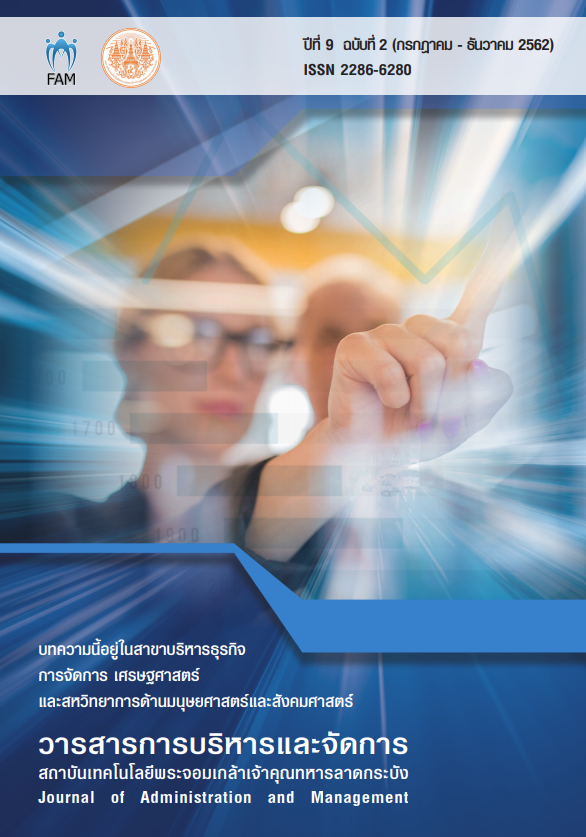Factors Determining Farmer’s Decision on Area Expansion of Oil Palm Plantation in Pak Phanang Basin Area, Nakhon Si Thammarat province
Main Article Content
Abstract
This study is a survey research aimed at analyzing the production characteristics, production management and also focused on the factors influenced to the expansion of cultivated areas of oil palm that were outside zoning areas in Pak Phanang Basin Area, Nakhon Si Thammarat province. The data were collected using structured questionnaires from a total sample of 405 oil palm farmers. Appropriate descriptive statistics and logistic regression were applied to analyze such factors. The study found that farmers in the area study had a small oil palm plantation. Most of planted areas located in the flooded area in the rainy season, causing the need to be improving plantation area before planting. For production management and harvesting, there was no shortage of labor and the problem of distribution oil palm products. Most farmers’ income had increased and become more stable. However, most farmers in the area did not have plans to expand the oil palm planting area. Moreover, the result revealed that the factors affected to the expansion of oil palm areas, number of household member, knowledge of oil palm plantation, source of distribution oil palm fruits, improving plantation area and source of water were those of positive significant factors on the decision of farmers to expand new planting areas. Whereas the factors, main occupation and membership of farmers groups were found to had negative significant influences on the decision of expansion of oil palm plantation.
Article Details
Journal of KMITL Business School is available both online and in printed version.
**All articles or opinions presented in this issue of the Journal of KMITL Business School reflect the thoughts of their respective authors. This journal serves as an independent platform for a variety of viewpoints. Authors bear full responsibility for the content of their articles.**
**All articles published in this journal are copyrighted by KMITL Business School, King Mongkut's Institute of Technology Ladkrabang. The editorial team permits copying or using articles, but a reference to the journal is required.**
References
ประชิด ทองน้อย (2551). การยอมรับเทคโนโลยีการผลิตปาล์มน้ำมันของเกษตรกรในเขตพื้นที่โครงการพัฒนา ลุ่มน้ำปากพนัง. วิทยานิพนธ์ปริญญาโท, มหาวิทยาลัยสุโขทัยธรรมาธิราช.
ปุรวิชญ์ พิทยาภินันท์, บัญชา สมบูรณ์สุข, ธีระ เอกสมทราเมษฐ์ และพลากร สัตย์ซื่อ. (2556). ปัจจัยกำหนดการ ตัดสินใจขยายพื้นที่เพาะปลูกปาล์มมันของเกษตรกรในอำเภออ่าวลึก จังหวัดกระบี่. วารสารวิจัย มข. (บศ.) 13(4): หน้า 1-13.
พลากร สัตย์ซื่อ และปุรวิชญ์ พิทยาภินันท์ (2558). การตัดสินใจปลูกปาล์มน้ำมันในพื้นที่นาข้าวของเกษตรกรใน อำเภอกระแสสินธุ์ จังหวัดสงขลา. วารสารวิชาการมหาวิทยาลัยราชภัฏสงขลา, 8(1): หน้า 81-98.
ไพฑรูย์ ไกรพรศักดิ์. (2559). เศรษฐมิติ. กรุงเทพฯ: สานักพิมพ์แห่งจุฬาลงกรณ์มหาวิทยาลัย.
สุรกิตติ ศรีกุล, ไพบูรณ์ เปรียบยิ่ง, ฐปนีย์ ทองบุญ, สุธีรา ถาวรรัตน์ และธีรชาต วิชิตชลชัย (2555). การพัฒนาการ ผลิตปาล์มน้ำมันในพื้นที่ลุ่มน้ำปากพนัง. สำนักวิจัยและพัฒนาการเกษตรเขตที่ 7, ศูนย์วิจัยและพัฒนาการเกษตรนครศรีธรรมราช.
อัจฉรา ทองประดับ (2553). การวิเคราะห์ผลกระทบต่อความมั่นคงด้านอาหารของครัวเรือนจากการเปลี่ยนพื้นที่ นาข้าวเป็นพืชเศรษฐกิจอื่นๆ ในตำบลการะเกด อำเภอเชียรใหญ่ จังหวัดนครศรีธรรมราช. วิทยานิพนธ์ปริญญามหาบัณฑิต, มหาวิทยาลัยสงขลานครินทร์.
อาคม โสวณา (2552). โครงการวิจัยการพัฒนาการมีส่วนร่วมของประชาชนในการจัดการลุ่มน้ำสายบุรีการปลูก ปาล์มน้ำมันในพื้นที่นาร้าง. สำนักงานกองทุนสนับสนุนการวิจัย (สกว.).
Mai, G., Su, S., Xiao, R., Yang, C. and Zhang, Z. (2015). Quantifying determinants of cash crop expansion and their relative effects using logistic regression modeling and variance partitioning. International Journal of Applied Earth Observation and Geoinformation, 34, 258-263.
Su, S., X. Zhou, C. Wan, Y. Li and W. Kong. (2016). Land use changes to cash crop plantations: crop types, multilevel determinants and policy implications. Land Use Policy, 50, 379-389.
Wilson VanVoorhis, C. R. and B. L. Morgan. (2008). Under¬standing power and rules of thumb for determining sample sizes. Tutorials in Quantitative Methods for Psychology, 3(2): 43-50.


